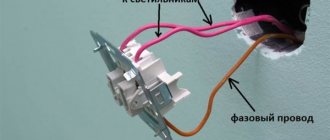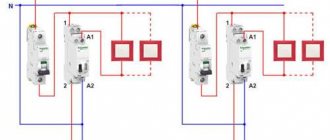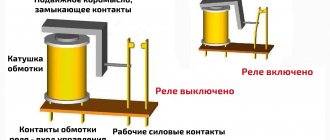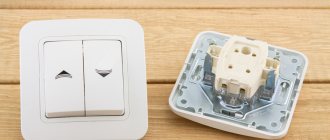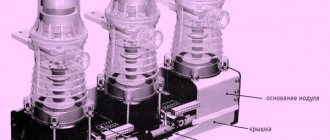Regardless of how familiar each of us is with electricity and the laws of electrical engineering, everyone knows the simplest device “switch”. During the whole day we use it more than a spoon or fork - at home, at work, in public places. Therefore, it is so important to get to know this device better, to find out what it consists of, what types there are, what the principle of operation is based on and how to properly connect it to the electrical network. In this article we propose to talk in detail about a device that is in the middle between the simplest and more complex ones. This is a switch with two keys. Those who independently repair the electrical network at home will probably be interested in the connection diagram for a two-button switch.
Purpose
types of switches
Despite all the variety of devices for controlling lighting (button, cord, chain, slider, dimmers, remote switches, timers), the keyboard option still remains classic. And the principle of operation is the same for all: the working mechanism has two main positions (“on”, “off”) and performs two main functions - to close the electrical circuit and apply voltage to the lighting element, to open the circuit and remove the voltage from the lamp.
A two-key switch is installed in household electrical networks with voltages up to 1000 V; the main purpose of its use is to turn chandeliers, light bulbs, and lamps on and off. The main advantage of a 2-key switch is two contact terminals at the output, to which two independent groups of lighting devices can be connected.
Installing a two-key household switch is used in the following cases:
- When the apartment has a separate bathroom and both rooms are located next to each other through the wall. In this case, it will be very convenient to connect a double light switch and install it just on the wall partition between the doors of both rooms. One key will turn on the lights in the bathroom, the second key will turn on the light in the toilet.
- Connecting a two-key switch is advisable when a chandelier with five or more arms or spotlights on the ceiling is installed in a large living room or office space. It is not always necessary for all the bulbs in a chandelier to light up at once; sometimes dim light is enough. For example, you can apply voltage to only two lamps by turning on one key. The second key will remain disabled, the remaining light bulbs in the lamp will not light up, thereby saving energy. Indeed, in the case when there is a single-key switch, when it is pressed, all the lamps in the chandelier light up at once. And if you calculate how much each extra burning light bulb consumes per kilowatt, you will get a decent amount in rubles per month. Why pay extra?
- Often a double switch for two light bulbs is used in country houses. It is best to install it in rooms located close to the exit to the street. One button turns on the light in this corridor, and the second turns on the street lamp.
How to replace a single-key switch with a two-key switch?
Independent dismantling of a switch with one button and installation of a device with two buttons is carried out in the following order:
- Turn off power.
- Remove the single-key switch by disconnecting the wires and loosening the screws of the spacer legs.
- Turn on the power. Find the phase wire and mark it.
- Prepare the new switch for installation by loosening the screw terminals and the screws of the spacer tabs.
- Shorten and strip the old wire if the ends are burnt or cracked.
- Insert the wires into the contact holes: the phase wire into terminal L, the other two into connectors 1 and 2. Tighten the screws.
- Install the 2-key switch in place of the old one, securing it with sliding tabs.
- Check correct operation and install decorative elements.
Replacing a one-button switch with a two-button one is possible if the wiring allows it. In other words, there should be three wires in the socket box. Otherwise, you will need to pull an additional cable from the transfer case. This can only be done by an electrician during a major overhaul.
Kinds
Before you connect the switch, you need to clearly determine what kind of switching device you will need. According to their design, they are available for indoor and outdoor installation. At first glance, it seems that there is no difference - both one and the other have two keys. If you look in more detail, you will understand that they differ in many parameters - scope, installation method, type of electrical wiring.
For indoor installation
This is the most common type of light switch; it is also called “recessed”; it is mounted in the wall and is used in residential premises and office buildings.
The connection diagram for such a two-key switch involves the use of hidden electrical wiring. This is when the wires are laid in special grooves made in the wall (electricians call them grooves) or inside frame plasterboard walls.
In order to connect this type of device, you will also need to additionally mount a socket box, which is a mounting box. The socket box is inserted into a hole in the wall, to which the grooves with wires fit, and the working part of the switch is already located in it. Socket boxes, in turn, also come in two types: for plasterboard and concrete walls.
Of course, you can guess how much dirt and dust there can be in an apartment when using a grinder to cut grooves in the wall and knock out a hole for installing a socket box. Therefore, it is advisable to combine the installation of hidden wiring and the installation of internal switches with general repair work in the room.
For outdoor installation
An external type switch is connected with open wiring. This is when electrical wires are laid along the walls. They can be laid in metal, plastic or flexible corrugated pipes, in special boxes or cable channels made of plastic. Or they can pass directly along the walls on porcelain insulators. This method, one might say, is already outdated and not very popular, but even now there are situations when the wiring cannot be hidden inside the wall.
Most often, the connection diagram for a double switch for two lamps is used in dachas. And since country houses are often made of wood, this is where outdoor switching devices have found their widest application. This wiring method and type of switch are also used in outbuildings, sheds, basements, cellars, garages, as well as in utility and industrial premises.
Of course, hidden and exposed wiring, external and internal switches cannot be compared in terms of aesthetics. Naturally, the room looks more beautiful when the wires are all hidden and not hanging on the walls. But in terms of speed and ease of wiring and connecting the switch, the external type wins.
Keep in mind! If you suddenly need to urgently make at least some lighting in a non-residential area, for example, in a newly purchased new house or apartment, to begin repair work, use open wiring and an outdoor switch as a temporary option.
Safety rules at work
Although replacing a switch is a simple task, it remains extremely dangerous. Mistakes made can lead to fire, failure of lighting equipment, or even electric shock to the person carrying out the work.
Basic safety rules:
- Power outage . Anyone can accidentally touch a bare wire, so before work, be sure to turn off the apartment’s circuit breaker.
- Studying the instructions . Switches are produced according to standards, but sometimes there are unique options with other connection schemes. Before installation, be sure to read the instructions.
- Protective clothing. Rubber gloves are a must. Safety glasses and special boots will also be useful.
Rubber gloves and suitable tools. - Instrument insulation . It is better to use tools with a rubber handle. They can also be additionally covered with electrical tape.
Options and selection tips
Before connecting a two-key light switch, it would be a good idea to familiarize yourself with the basic characteristics of this switching device. In the modern market of electrical goods, their choice is so huge that you can get confused.
Any model is created for a certain amount of operating current, as a rule, it is 4A, 6A and 10A. If you need to connect a chandelier with a large number of lamps, for reliability it is better to choose a device with a rated operating current of 10A.
To connect the switching device to the power supply network, wires with a cross-section of 1.5 to 2.5 mm2 are usually used. In most switches, wires are connected to its terminals using screw terminals. Now there are more modern models with spring-loaded terminal blocks; in them, wire installation is much easier; you just need to insert the stripped tip into the clamping device. We advise you to choose this option when purchasing switches.
You can ask the seller what mechanism the keys operate on - cam or rocker. And also what the base of the switch is made of, it can be metal or ceramic; the second option is preferable and safer due to the low thermal conductivity of ceramics.
Nowadays it is easy to choose a model that is suitable specifically for your interior; the market offers a huge selection of switches in any color.
When purchasing, be sure to click the keys; they should work clearly, lock well, and make a characteristic click when turned on and off.
Modern models are often backlit. This is very convenient, you can safely choose this option. In the dark, when you enter a room, you can easily determine the location of the device by its luminous elements.
Selecting a switch from the point of view of an interior designer (video):
Advice! Try to buy switches and materials for connecting it at electrical goods stores. There is not only a huge selection, but also sales consultants who can explain all the parameters, characteristics and technical capabilities of the selected model.
Structural device and principle of operation
The switch with 2 keys is not difficult to set up.
The main part is the working mechanism installed in the socket box. Its fixation in the mounting box occurs in two ways, depending on the model of the switch:
- using a metal frame, in which there are specially designed holes for this;
- using spacer feet.
The main part of the working mechanism is three contacts:
- one incoming, which must be connected by wire to the power source;
- two outgoing wires from them go to two groups of lighting fixtures (or to two different rooms - a toilet and a bathroom).
All these contacts are fixed, and the connection between them is carried out using movable contacts, also located in the working part.
The switch also has protection consisting of two keys and a frame, they are made of plastic. Each key is attached to one drive mechanism; by pressing it will close the incoming and outgoing contacts, thereby supplying voltage to one group of lamps. A frame made of dielectric material is attached on top to prevent the possibility of touching the working part of the switch with your hand. It is secured with latches or two screws.
Now let's summarize all this a little. A wire comes from the distribution box to the incoming fixed contact of the switch, through which voltage is supplied from the power source. You press one key, with the help of a moving contact the fixed ones (one incoming and one outgoing) are closed, through the resulting closed circuit the voltage is supplied to one group of lamps and the bulbs in it light up. Press another key in the same way and activate the second group of lamps.
The reverse process occurs exactly the opposite. They pressed the key in the opposite direction, the moving contact opened the circuit between the incoming and outgoing fixed contacts, voltage can no longer flow through the broken chain and the lamps on the lamps do not light.
